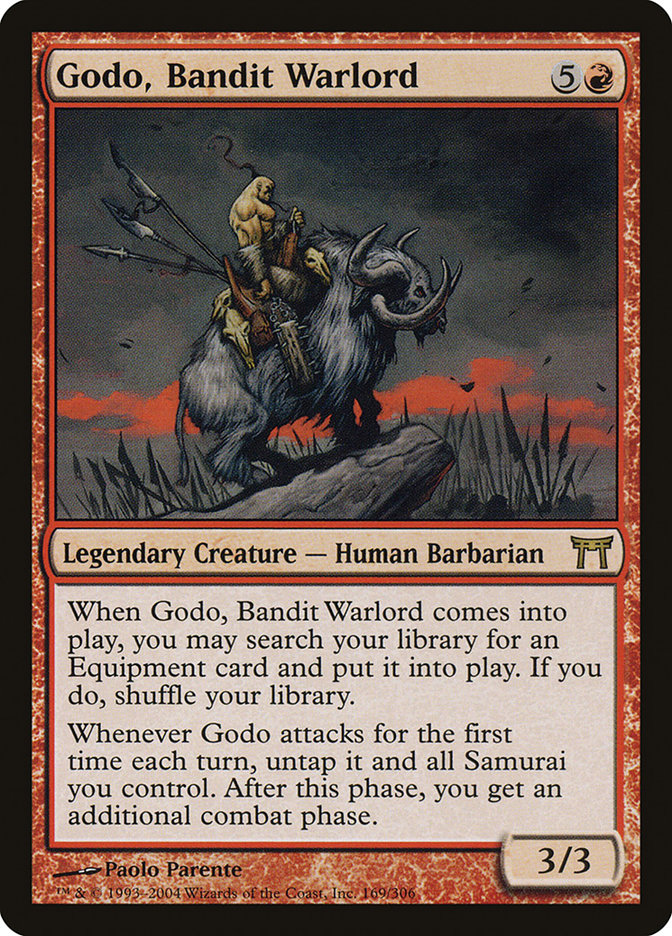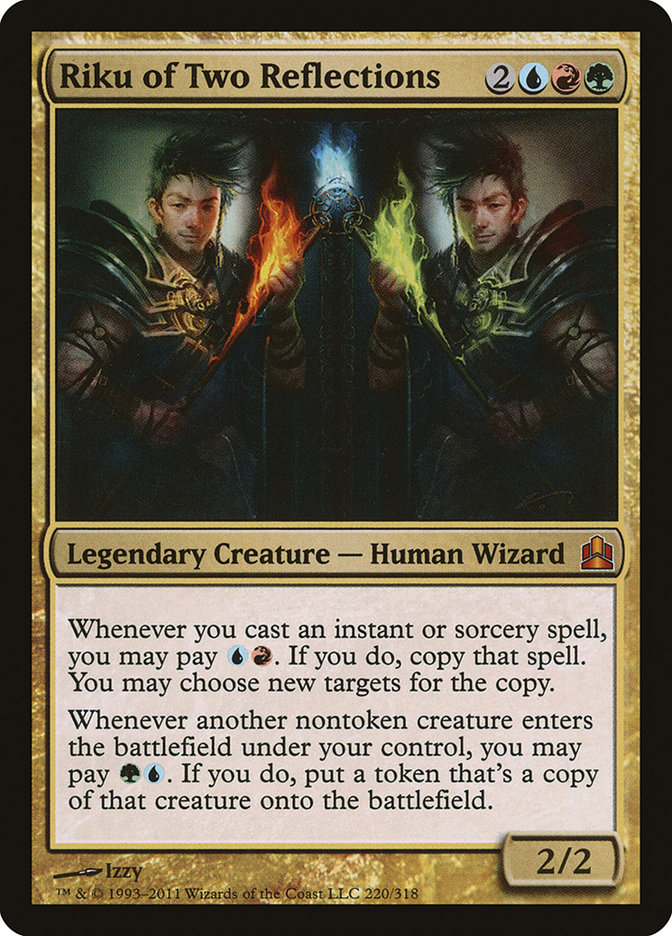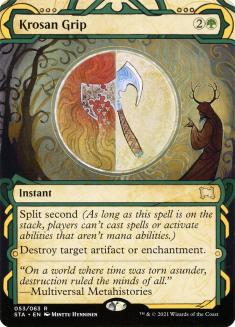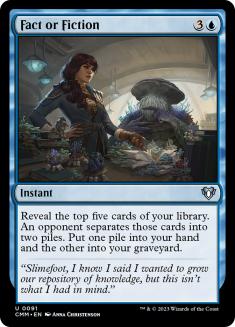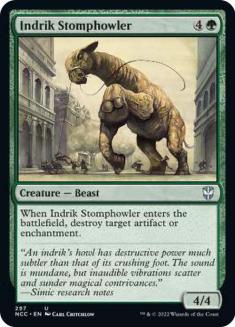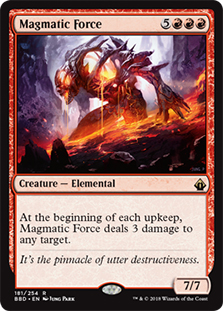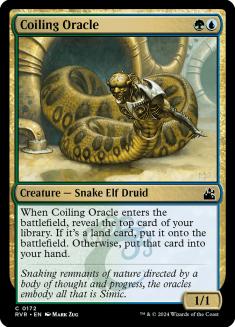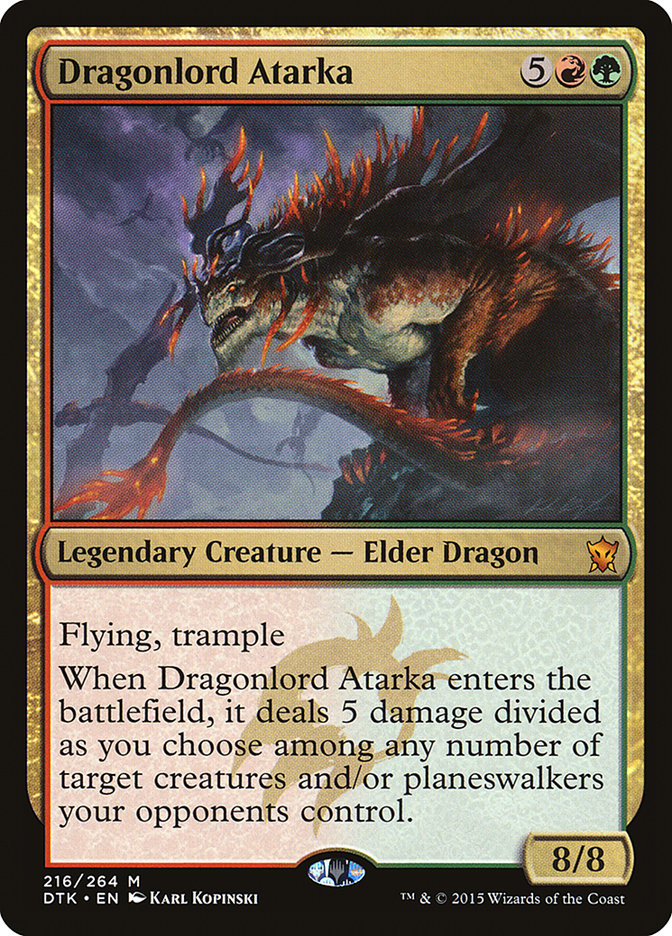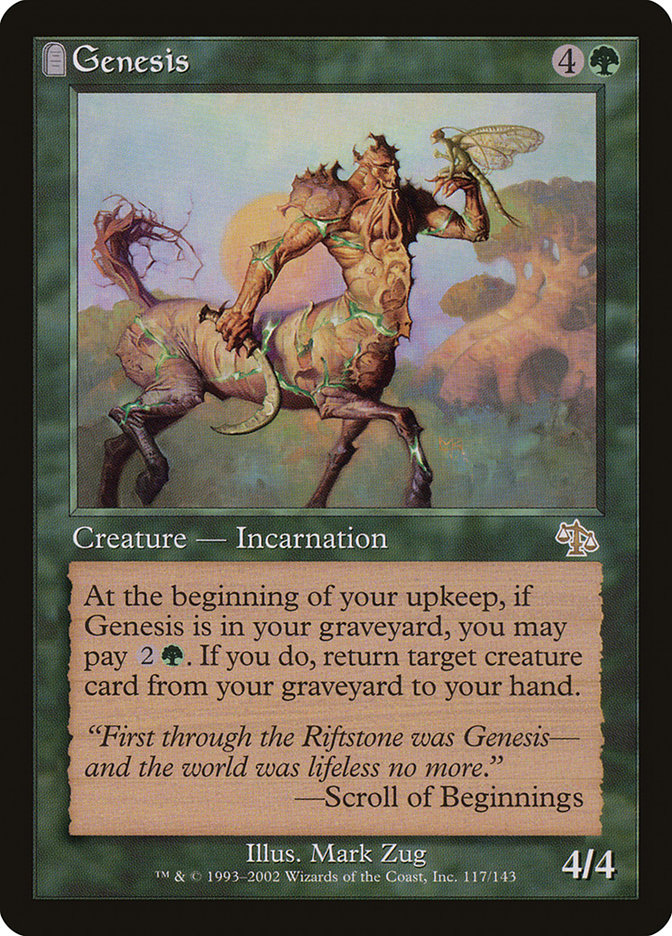 Oros, the Avenger; and my Atarka, World Render deck. I pack them for specific reasons. Oros, the Avenger is the very first Commander deck I built back when Time Spiral was Standard-legal. But Atarka, World Render is not my favorite deck. It isn’t even close to my favorites of the bunch. Yet I bring it every single time. It is my loaner deck, my newbie deck, my “My First Commander” deck.
Oros, the Avenger; and my Atarka, World Render deck. I pack them for specific reasons. Oros, the Avenger is the very first Commander deck I built back when Time Spiral was Standard-legal. But Atarka, World Render is not my favorite deck. It isn’t even close to my favorites of the bunch. Yet I bring it every single time. It is my loaner deck, my newbie deck, my “My First Commander” deck.
Years ago I had a Vorosh, the Hunter deck that was filled with haymakers and I would lend that to new people to try out the format. But it had some complexities and things that I liked that newer players didn’t.
So I started lending Godo, Bandit Warlord instead. It was useful and straightforward, but the deck had issues. Godo would die a lot. Then I made Isperia the Inscrutable, which was a huge ball of fun (it even had a cheat sheet for people), but every time she connected, a new Commander hopeful had to tutor through a huge deck and hope to pick the right flyer. Sometimes it was easy, but most times it was a chore.
Then I made Riku of Two Reflections, a deck I built from the ground up to be used for newbies who showed up and wanted to join in the Commander fun. “No deck, no worries. Play this one. You want to ramp hard early, cast Riku of Two Reflections, and then go nuts playing twice as much Magic as everyone else.” That was the pitch. I would explain a rough guideline, let players search the deck, and tell them to use Riku’s triggers as often as possible.
Since then, I’ve learned a lot about having a My First Commander deck to lend to whoever shows up for Commander. I made a lot of mistakes with Riku. I even wrote into Dear Azami for help. This did help a lot, but the deck had an inherent problem with decision trees. It was one I didn’t see because I was used to eliminating bad options and making better decisions for Commander games, but the player who just showed up to Commander Night…not so much. I know that I need to Krosan Grip an opponent’s Oblivion Stone, but the new player was still figuring out how to best spend seven mana with the following cards in hand:
When you are brand new to the format and have seven mana with all your colors and Riku out, this hand’s decision tree slows down the game long enough for a coffee run. You want to avoid overwhelming the new player, and it was something I didn’t properly consider until later.
Goals for a New Player Deck
It Must Show Why Commander Is Awesome
This is the most obvious goal for a new player deck. You are selling the player on the format. We get to play spells that no other format uses, some of the most ridiculous cards to come out of Magic design, and they kick serious butt. So showcase some of this.
Riku of Two Reflections had loads of cool cards and big silly creatures. Play stuff like Insurrection or Genesis Wave or Stormtide Leviathan. Ramp up the deck with Sol Ring or Thran Dynamo; only Vintage can use Sol Ring and Thran Dynamo hasn’t really been seen since Kai Budde sleeved up Wildfires. It’s been a while.
Offer Powerful Plays Instead of a Synergy Machine
This point ties into the above with showcasing the coolness of the format. However, this goal is more about the gameplan for the deck. I highly suggest you hand a new player a deck with haymakers and big splashy Timmy plays over a synergy machine that snowballs an opponent. A complicated Sharuum the Hegemon combo deck using Phyrexian Metamorph / Sculpting Steel with Altar of the Brood / Zulaport Cutthroat / Blood Artist as a main kill with Thopter Foundry, Sword of the Meek, and Time Sieve as a backup is a nightmare to hand to a new Commander player.
There are multiple combinations with distinct parts attempting distinct goals. Plus, a new player needs to know what to keep in hand, what to put in the graveyard, and what to tutor… and to stay alive playing a known combo general with a well-deserved reputation. A deck with fewer synergistic components and more big plays is certainly easier to understand and fun to play, even if things don’t all work out in the end.
Limit Tutors and Enjoy Variance
Another goal is to limit tutors. It is not that running a bunch of Dark Petitions and Demonic Tutors and Mystical Tutors is exactly bad. It is the message it sends to a new player. You should (ideally) be showing off the neat cards that typically don’t fit into a 60-card deck.
A deck with a pile of tutors eventually becomes a deck that moves from running 100 cards to running about fifteen and winning. This is not the best way to illustrate the fun in a large-deck format. Instead, I suggest you embrace a greater amount of variance (or build in more redundancy if something is critical) to let a new player enjoy the options.
Plant Fewer Decision Trees
Decision trees lead to analysis paralysis and mental fatigue. Veteran players have more stamina for this fatigue and are skilled at cutting bad ideas or lines of play. This essentially becomes a high-speed pruning for a mental tree in a game. At first this is a lot of effort, but it becomes more instinctive and takes far less cognitive space.
Players new to Commander do not have this developed yet. It is entirely possible this mental muscle memory is developed for tournaments, but the decision tree for Anguished Unmaking is a lot more complicated with three opponents and hefty battlefield states. Good plays should be obvious, and wherever possible, try to build a deck that is forgiving of non-optimal sequencing or playing of threats.
Encourage Combat
Players really enjoy combat. Wizards keeps printing better creatures to facilitate this. I tried this with Godo, Bandit Warlord; Isperia the Inscrutable; and Vorosh, the Hunter. But the decks always had other things going on that got in the way.
I recommend you hand someone a big stompy deck to rumble into the red zone and wreck some opponents. If you build a My First Commander, going with a combination of red, green, and white is usually the easiest way to help get into the red zone. Make sure you have ways to break through a stalemate or complicated battlefield position via Overrun effects or Rogue’s Passage and other effects that prevent blocking.
Follow the Social Contract
The most important goal for My First Commander is to follow the social contract for your group or store. Having a deck for new players like Numot, the Devastator in a group that despises land destruction will be a terrible experience for a new player.
Similarly, don’t build a deck that is going to pull off turn 4 or turn 5 kill when everyone wants to settle in for a much more casual game. Follow your group norms so that the new player gets to enjoy the game and experience how Commander works. Don’t build a deck that turns the game into Archenemy.
Why Atarka, World Render?
I built Atarka, World Render when Fate Reforged came out and have been tweaking it since. The deck is Dragon tribal with a Voltron option too. I chose this for a new player deck mostly because Dragons are really cool. The double strike effect makes the dragons even better. Double striking Dragons are Plan A and regular Dragons are Plan B, not too shabby considering many decks use big dumb fliers as a first win condition. I kept the decision tree and tutoring to a minimum, but left in a couple so that a player can find an answer or reload with a new dragon after a sweeper.
The main plan is to ramp, get out a haste enabler, and go to town. Pump effects like Crucible of Fire are win-more cards in tournaments. But in Commander, that three-power boost is really important for the Dragons surviving combat and closing out games.
Recently the deck has been seeing a lot of play when my girlfriend comes to my LGS with me; she says that Commander games have so many triggers and responses to things that she appreciated just bopping people with Atarka. She also likes that the Dragons help her go from being behind in the game to smashing face pretty quickly.
New players are still learning the format and do not need to worry about being creative; they need to keep up with multiple opponents and a radically shifting battlefield state. The tribal nature of the deck keeps the game relatively simple for a player: just keep playing Dragons and attacking.
Many people have encouraged me to change the commander to Dragonlord Atarka. This is a fine choice, but I don’t like the switch. If this deck were for me, I would certainly change the commander because Atarka, World Render draws more hate from a table than Dragonlord Atarka. But I want a new player to be able to take down anyone in two hits.
The deck plays out its hands and can get a bit stalled on gas; Atarka, World Render is the solution to this. She always hits hard and can always be played. If a new player is pitted against Captain Wraths-A-Lot, I wanted there to be an out. I can dig and play from a weird angle to find an answer, but I do not want someone playing Commander for the first time to have to deal with this. Just attack with Atarka and solve all your problems. With no more ado, I present the decklist.
Creatures (22)
- 1 Dragonspeaker Shaman
- 1 Genesis
- 1 Anger
- 1 Dragon Tyrant
- 1 Dragon Mage
- 1 Fierce Empath
- 1 Bogardan Hellkite
- 1 Dragon Broodmother
- 1 Hellkite Charger
- 1 Steel Hellkite
- 1 Mana-Charged Dragon
- 1 Thundermaw Hellkite
- 1 Utvara Hellkite
- 1 Stormbreath Dragon
- 1 Burnished Hart
- 1 Scourge of the Throne
- 1 Tyrant's Familiar
- 1 Harbinger of the Hunt
- 1 Dragonlord Atarka
- 1 Dragonlord's Servant
- 1 Thunderbreak Regent
- 1 Savage Ventmaw
Planeswalkers (3)
Lands (38)
Spells (36)
- 1 Urza's Incubator
- 1 Sol Ring
- 1 Rampant Growth
- 1 Darksteel Ingot
- 1 Fires of Yavimaya
- 1 Lightning Greaves
- 1 Dragonstorm
- 1 Fire Diamond
- 1 Hull Breach
- 1 Krosan Grip
- 1 Search for Tomorrow
- 1 Gaea's Anthem
- 1 Harmonize
- 1 Rootgrapple
- 1 Crucible of Fire
- 1 Where Ancients Tread
- 1 Soul's Majesty
- 1 Relic Crush
- 1 Vines of Vastwood
- 1 Basilisk Collar
- 1 Overwhelming Stampede
- 1 Slice in Twain
- 1 Hunter's Insight
- 1 Swiftfoot Boots
- 1 Hammer of Purphoros
- 1 Hunter's Prowess
- 1 Unstable Obelisk
- 1 Commander's Sphere
- 1 Frontier Siege
- 1 Return to the Earth
- 1 Dragon Tempest
- 1 Atarka's Command
- 1 Sarkhan's Triumph
- 1 Atarka Monument
- 1 Elemental Bond
- 1 Zendikar Resurgent

New Player Problems
I want to wrap up with some things to think about when building a Commander deck for new players, and more specifically when teaching Commander. How many cards in a Commander game do you need to read? A few, I bet. Now imagine you are coming from not playing much Magic, or Standard, or Modern. How many cards will you need to pick up and read? A lot more.
We play a load of cards that most players have never seen before (Dragonspeaker Shaman and Genesis, for example). This often leads to a new player not understanding their deck and letting their eyes glaze over at the table.
I wouldn’t begin explaining counseling theories with an analysis of how Cognitive Behavioral Therapy is useful for first-year college students. Do not begin a Commander game by explaining what the opponent’s decks are doing! Explain the game plan of My First Commander and then give a brief strategy of the opponents: “Your deck is an aggressive Dragon tribal deck. Get there with Atarka and double striking Dragons. The Dragonlord Ojutai deck is a control deck; Ghave, Guru of Spores is mostly tokens; and Phelddagrif has some group hug cards that help everyone and stuff that cares about hand size.”
New players often get lost in knowing what cards impact them. This is not a big deal, and please do not scoff at a new player asking lots of questions! Explain what effect just happened and what changed on the battlefield. Announce all the cards you play, and let the new player know what they can just kind of skip over (the Dreamstone Hedron is just a bigger version of Hedron Archive; it’s just a big mana artifact that can be sacrificed to draw some cards).
When podding up, explain what is happening. My LGS uses playing cards to match people into pods. Either make sure you can help the new player, possibly by sitting out of a game or two for coaching, or have the new player explain to the pod that they are new. Yeah, it seems silly, but letting a pod know that card nicknames need to be dropped and the pace slowed down a bit makes a huge difference for a new player. Make sure they give the new player time to figure out combat or something else that is complicated. We aren’t playing for prizes. If you are, don’t teach someone Commander this way; there shouldn’t be a huge rush to end the game.
Another good thing to do with a new player is take them aside and play a game or two where you walk them through the thought processes of a play. Explain how something sets up a later play or how a hugely impactful Standard or Modern card isn’t a big deal in Commander; Tarmogoyf, I’m looking at you.
Remember, you are functionally selling the new player on the format. If they aren’t having a great time, they are less likely to come back and play again. I’m not saying to throw the game, but don’t bring the precision weapon of a tournament-level Commander deck when you are teaching a new player how the format works. If you do your job correctly, with luck you’ll be lending the deck for a bit and then helping them make their first Commander deck.
Let me know your My First Commander decks and tips for getting people into the format!


